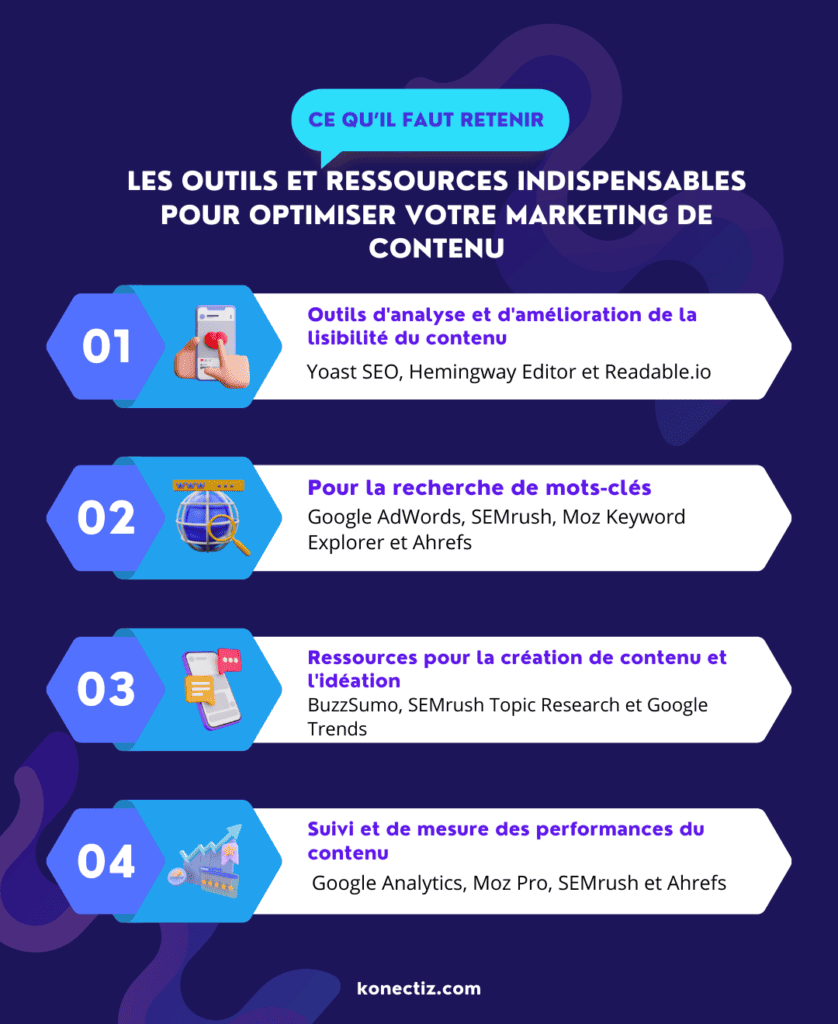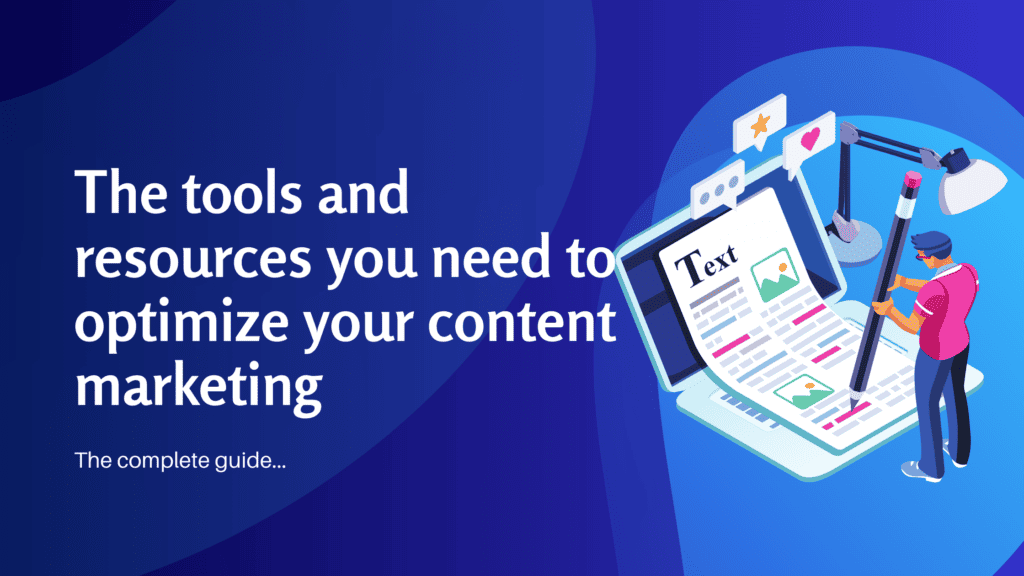Introduction
Welcome to our comprehensive guide to the tools and resources you need to optimize your content marketing. Whether you’re a small business or a large corporation, content marketing is an essential part of your overall online marketing strategy. But to succeed and maximize your impact, you need the right tools and resources.
In this article, we present a selection of the best tools and resources available on the market to help you improve your content marketing. Whether you’re looking for tools for keyword research, SEO optimization, content creation or performance analysis, we have everything you need.
What’s more, we’ll give you practical advice on how to use these tools and resources effectively to boost your online visibility, attract more qualified traffic and convert your visitors into loyal customers. Don’t miss this opportunity to take your content marketing to the next level.
Ready to get started? So let’s dive into the exciting world of content marketing optimization!

Why is content marketing optimization important?
Before diving into the tools and resources that will help you improve your content marketing, it’s essential to understand why content marketing optimization is so important. Content marketing is a key element of your online marketing strategy, enabling you to attract and engage your target audience in a meaningful way.
However, to maximize your impact, you need to ensure that your content is optimized for search engines and meets the needs and expectations of your audience.
By optimizing your content marketing, you can improve your online visibility, attract qualified traffic and convert your visitors into loyal customers.
By using the right tools and resources, you can identify the most relevant keywords, optimize your pages, analyze and improve the readability of your content, monitor and measure the performance of your content, plan and develop an effective content strategy, create compelling content and promote it in a targeted way. All this contributes to the growth of your business and the achievement of your marketing objectives.
Now that you understand the importance of content marketing optimization, let’s review the essential tools and resources to maximize your success.
Key tools for keyword research
Keyword research is a crucial step in optimizing your content. Keywords are the terms that users enter into search engines to find relevant information. By using the right keywords in your content, you increase your chances of appearing in search results relevant to your business.
There are many tools available to help you in your keyword research. One of the most popular is the Google AdWords keyword planning tool. This tool enables you to find keywords relevant to your business, get statistics on their search volume and competition, and discover new keyword ideas. You can also use tools such as SEMrush, Moz Keyword Explorer and Ahrefs to obtain more detailed information on keywords relevant to your niche.
By using these keyword research tools, you can identify the most relevant terms for your content, integrate them strategically into your titles, subheadings and texts, and thus improve your positioning in search results.
Tools for page optimization
On-page optimization is another essential component of your content marketing strategy. Search engines attach great importance to the structure and quality of your pages, as well as the user-friendliness of your website. To optimize your pages, you can use tools such as Yoast SEO, SEOptimer and Moz On-Page Grader.
These tools enable you to analyze your pages and receive recommendations for improving their structure, HTML markup, loading speed, mobile-friendliness and accessibility. They also help you optimize your title tags, meta descriptions, header tags, URLs and images for search engines.
By optimizing your pages with these tools, you improve your ranking in search results, increase your online visibility and encourage users to click on your links.
Tools for analyzing and improving content readability
The readability of your content is an important factor in attracting and keeping your audience’s attention. If your content is difficult to read, users will be less inclined to stay on your site and consume your content.
Fortunately, there are tools available to analyze and improve the readability of your content. One of the most popular tools is Yoast SEO, which offers a built-in readability feature. This tool evaluates the readability of your content according to criteria such as sentence length, word complexity, use of subheadings and text structure. It gives you specific recommendations for improving the readability of your content, helping you to attract and retain the attention of your audience.
Other tools such as Hemingway Editor and Readable.io can also be used to analyze the readability of your content and give you advice on how to make it clearer and more accessible.
By using these tools, you can ensure that your content is easy to read and understand, which will improve the user experience and encourage users to stay longer on your site.
Tools for monitoring and measuring content performance
It’s essential to monitor and measure the performance of your content to understand what’s working and what’s not, and to make any necessary adjustments to your content marketing strategy.
There are many tools available to monitor and measure the performance of your content. Google Analytics is one of the most popular and powerful tools available. It allows you to track traffic to your website, find out which pages are most popular, identify traffic sources, measure conversions and monitor your business objectives.
By using Google Analytics, you can gain valuable insights into your users’ behavior, the pages that generate the most traffic, the keywords that bring you the most visitors, and much more. This information helps you understand what works and what doesn’t, and guides you in optimizing your content and marketing strategy.
Other tools such as Moz Pro, SEMrush and Ahrefs can also be used to monitor and measure the performance of your content, as well as tracking keyword rankings, website visibility and inbound links.
Resources for content planning and strategy
Before creating content, it’s essential to have a clear, well-defined strategy. A solid content strategy enables you to focus on your company’s objectives, meet the needs of your target audience and create relevant, engaging content.
There are many resources available to help you plan and develop an effective content strategy. One of the most useful resources is an editorial calendar. An editorial calendar lets you plan the content you’ll create in advance, defining publication dates, topics, targeted keywords and objectives for each piece of content.
You can use tools such as Trello, Asana and CoSchedule to create and manage your editorial calendar, as well as collaborate with your team and track the progress of your content.
Other useful resources include content strategy templates, keyword research guides, examples of successful content, case studies and online training.
Using these resources, you can create a solid content strategy and develop an effective editorial calendar, enabling you to produce relevant and consistent content.
Resources for content creation and ideation
Creating quality content is a key element of your content marketing strategy. To create engaging and relevant content, you need resources and tools to help you generate ideas, write powerful copy and create eye-catching visuals.
When it comes to generating content ideas, you can use tools such as BuzzSumo, SEMrush Topic Research and Google Trends. These tools enable you to discover the most popular topics in your niche, identify questions frequently asked by your audience and get ideas for new blog posts, videos, infographics and other types of content.
When it comes to writing content, tools such as Grammarly, Hemingway Editor and Google Docs can help you improve the quality of your writing. These tools check your content for spelling, grammar, punctuation and clarity, giving you recommendations for making it more accurate, fluid and professional.
Finally, to create eye-catching visuals, you can use tools such as Canva, Adobe Spark and Piktochart. These tools make it easy to create graphics, infographics, social networking images and other eye-catching visuals, even if you have no design skills.
Using these resources, you can create quality content that attracts and engages your audience, and stands out from the competition.
Resources for content promotion and distribution
Once you’ve created quality content, it’s time to promote and distribute it to your target audience. Promoting and distributing your content is essential to maximizing your online visibility, attracting qualified traffic and achieving your marketing objectives.
There are many resources available to help you promote and distribute your content. Social media is one of the most powerful channels for promoting your content. You can use tools such as Hootsuite, Buffer and Sprout Social to manage and schedule your social media posts, track post performance and interact with your audience.
E-mail is another effective way of promoting your content. You can use tools such as Mailchimp, ConvertKit and AWeber to create and manage youre-mail marketing campaigns, segment your mailing list and track conversions.
What’s more, you can collaborate with other content creators and influencers in your niche to mutually promote your content. You can also consider using online advertising tools such as Google Ads and Facebook Ads to increase your visibility and drive targeted traffic to your content.
By using these resources, you can effectively promote your content, reach your target audience and increase your online visibility.
Content optimization tools for voice search
With the rise of virtual assistants such as Siri, Alexa and Google Assistant, voice search is gaining in popularity. To optimize your content for voice search, it’s important to understand how users ask questions and adapt your content accordingly.
There are tools available to help you optimize your content for voice search. Answer the Public is one such tool. It allows you to find the questions most frequently asked by users around a given topic, giving you ideas for creating content optimized for voice search.
In addition, you can use keyword research tools such as SEMrush and Moz Keyword Explorer to identify long-tail keywords relevant to voice search. These keywords focus more on the questions and natural expressions used in voice search.
By adapting your content for voice search using these tools, you increase your chances of appearing in voice search results and attracting qualified traffic to your website.
Conclusion
Content marketing optimization is essential to maximize your online impact. By using the right tools and resources, you can improve your online visibility, attract qualified traffic, convert your visitors into loyal customers and achieve your marketing objectives.
This guide has presented you with a selection of the best tools and resources available on the market for optimizing your content marketing. From keyword research tools to content creation resources, performance measurement tools and promotion resources.





